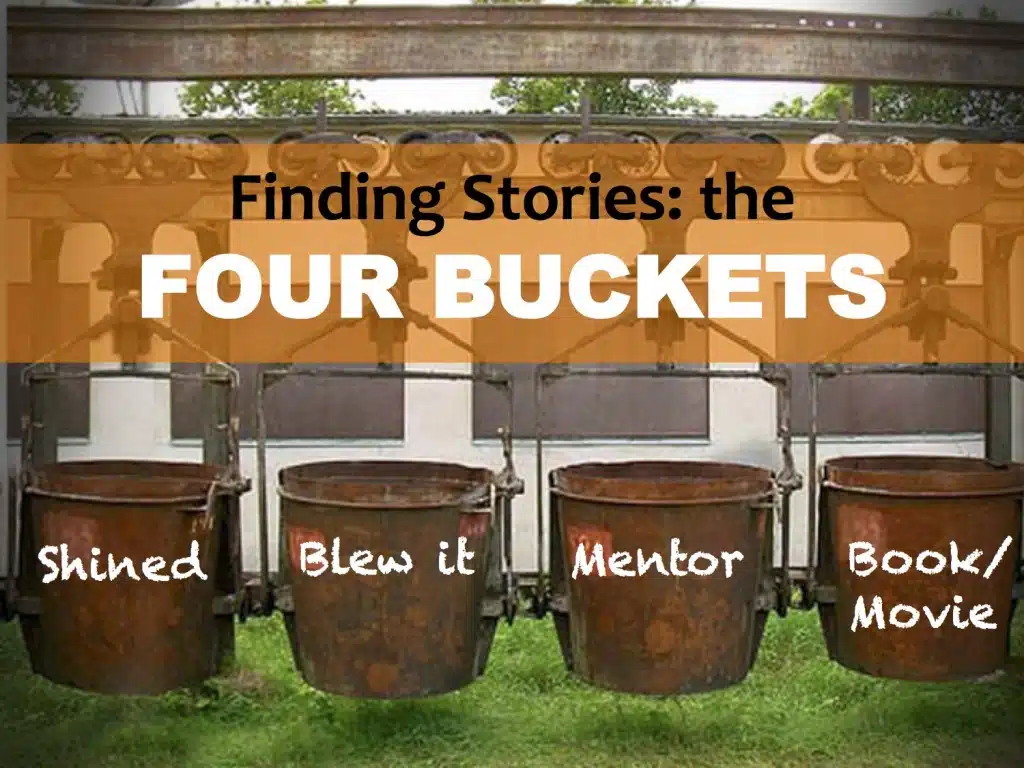In t
1. A time you shined
2. A time you blew it
3. A mentor
4. A book/movie/folk tale
These aren’t the only places to find stories, but they are easy and reliable. As you develop as a storyteller you will find new sources, and by then you’ll have your own methodology. In the meantime, there is no reason you can’t use these tools to find and deliver a great story as a part of a presentation you have to deliver in the next 24 hours.
A Time You Shined
This kind of story is about something good that happened to you. If you are communicating a quality like integrity, a value like compassion, or a learning situation, these stories will tell about a time in your life when it would’ve been easier to be anything but that quality you wrote down. All the outside pressures told you to do one thing, but you did the “right” thing and everything turned out for the best. You were being tested and you came through. Tell of a vision that kept you going or a time when you thought something smelled fishy but you were wrong.
A Time You Blew It
This is about a time when something bad happened and it was your fault. Sharing a personal failure, flaw, or embarrassing moment means that in the trust dance, you trust them enough to go first. When you go first, you get the ball rolling and people are more likely to trust you back. People can tell by the way you tell the story and the tone in your voice how hard you strive to never let it happen again. This works for all of the six kinds of stories. Teaching technical (boring) details that, forgotten will result in particularly disastrous results are well suited to this type of story. You don’t want students to learn first-hand that someone dies if they forget to check a label twice. Obviously, you can expand to “a time someone blew it” when appropriate.
A Mentor
The third kind of story could be your personal memories of an important person in your life, or the important impact a historical or famous person had on you. Share an experience via story about that person that brings him/her alive with detail. Your story of admiration and gratitude towards someone who embodies the qualities, skills, vision, or values you want to share, it demonstrates humility and gratitude. Humility and gratitude are vital in good leadership and are the essence of personal dignity. Your story provides clues for listeners to interpret – they may begin to associate that person’s qualities with your own. The only danger is if you push the association. Tell the story from a place of admiration only. There is nothing worse than, “I like to think I’m like Nelson Mandela” to turn people off.
A Book/Movie/Folk Tale
Stories from books, movies, newspaper articles, or other media sources are great sources and free to use as long as you site the source. If you want to retell someone’s personal story, ask their permission to repeat it. Chances are you have a favorite scene from a movie, book, TV show or current event that is just funny or meaningful and you haven’t examined why. If you think hard, that scene will probably work somewhere somehow for one of the six kinds of stories. You like it for a reason so use it. When you have to hunt for a story, focus on the concept you need to illustrate and ask someone to help you come up with ideas. Once you have found one watch or read the scene again closely, pull out descriptions that set the scene in context for people who are not familiar with the big story. And tell it with sensory details (George Clooney in drag) that conjure strong images. Match the pacing (a long silence for suspense, soft? loud?) Choosing a well-known book or movie takes advantage of all the hard work the author or director did stimulating senses and capturing attention. Make the story yours by adapting the format and style, including the details of how you came across this story, or by elaborating on what this story has meant to you and why you are sharing it.

